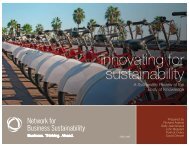embedding sustainability in organizational culture - Network for ...
embedding sustainability in organizational culture - Network for ...
embedding sustainability in organizational culture - Network for ...
Create successful ePaper yourself
Turn your PDF publications into a flip-book with our unique Google optimized e-Paper software.
Chapter 1: 5: Introduction Build<strong>in</strong>g Momentum <strong>for</strong> Change<br />
40<br />
raise aWareness<br />
This category looks at techniques used to encourage or conv<strong>in</strong>ce <strong>in</strong>dividuals of the<br />
importance of <strong>susta<strong>in</strong>ability</strong> <strong>for</strong> the organization or the need to take trans<strong>for</strong>mative<br />
action. These practices <strong>in</strong>clude trigger<strong>in</strong>g and fram<strong>in</strong>g.<br />
tRiggER: <strong>in</strong>itiate; create events that help set th<strong>in</strong>gs <strong>in</strong> motion; disrupt the<br />
status quo<br />
• Disrupt people’s patterns by po<strong>in</strong>t<strong>in</strong>g to the negative implications of<br />
current behaviours<br />
• Make use of visual displays to demonstrate the implications of<br />
current behaviours<br />
• Provide opportunities <strong>for</strong> employees to experience the implications<br />
of currently unsusta<strong>in</strong>able behaviour first-hand<br />
Sometimes it is necessary to disrupt the status quo to generate an understand<strong>in</strong>g of<br />
the need <strong>for</strong> change. Trigger<strong>in</strong>g is about demonstrat<strong>in</strong>g the risks of current thought<br />
patterns and build<strong>in</strong>g awareness of the benefits of alternatives (Doppelt, 2008).<br />
Consider br<strong>in</strong>g<strong>in</strong>g visibility to <strong>susta<strong>in</strong>ability</strong> issues by disrupt<strong>in</strong>g exist<strong>in</strong>g patterns<br />
(like plac<strong>in</strong>g wastebaskets down the hall <strong>in</strong>stead of <strong>in</strong> offices) or by creat<strong>in</strong>g visual<br />
displays (by display<strong>in</strong>g a day’s worth of waste) (NBS, 2010). To raise awareness<br />
among the senior leadership, Willard (2009) suggests provid<strong>in</strong>g opportunities <strong>for</strong><br />
them to experience the negative effects of current operations first hand. Similarly,<br />
Dunphy and colleagues (2003) suggest that plac<strong>in</strong>g employees <strong>in</strong> face-to-face<br />
situations with those who will be most affected by their work can powerfully impact<br />
attitudes.<br />
In the high-reliability organization literature, van Stralen (2008) expla<strong>in</strong>s how<br />
trigger<strong>in</strong>g episodes are important <strong>for</strong> alter<strong>in</strong>g perceptions about the implications of<br />
current practices. In his study, van Stralen demonstrates how <strong>in</strong>terventions ‘midaction’<br />
can provide employees with tangible evidence that different behaviours are<br />
required to achieve superior outcomes.<br />
We found no empirical work that explored the effectiveness of triggers <strong>in</strong> the context<br />
of <strong>susta<strong>in</strong>ability</strong>.<br />
assessment: proposed but not tested<br />
✔ fRaME: construct and present a fact or issue from a particular<br />
perspective<br />
• Frame <strong>susta<strong>in</strong>ability</strong> as a f<strong>in</strong>ancial opportunity or put it <strong>in</strong><br />
quantitative terms<br />
• Frame <strong>susta<strong>in</strong>ability</strong> <strong>in</strong> everyday bus<strong>in</strong>ess language<br />
• Frame <strong>susta<strong>in</strong>ability</strong> as urgent<br />
• Consider fram<strong>in</strong>g <strong>susta<strong>in</strong>ability</strong> as <strong>in</strong>novation or be<strong>in</strong>g ‘cutt<strong>in</strong>g edge’<br />
• Consider fram<strong>in</strong>g <strong>susta<strong>in</strong>ability</strong> as be<strong>in</strong>g about quality<br />
• Consider fram<strong>in</strong>g <strong>susta<strong>in</strong>ability</strong> <strong>in</strong> terms of ma<strong>in</strong>ta<strong>in</strong><strong>in</strong>g a licence to<br />
operate<br />
• Consider fram<strong>in</strong>g <strong>susta<strong>in</strong>ability</strong> as good publicity and contribut<strong>in</strong>g<br />
to reputation<br />
• Consider fram<strong>in</strong>g <strong>susta<strong>in</strong>ability</strong> as ‘the right th<strong>in</strong>g to do’<br />
• Consider fram<strong>in</strong>g <strong>susta<strong>in</strong>ability</strong> <strong>in</strong> terms of its benefits <strong>for</strong> employees<br />
• Avoid emotional language<br />
Practitioners <strong>in</strong> this review stressed the importance of fram<strong>in</strong>g <strong>susta<strong>in</strong>ability</strong> <strong>in</strong><br />
ways that reflect the organization’s values (NBS, 2010) and <strong>in</strong> language that aligns<br />
with <strong>organizational</strong> priorities (Ethical Corporation, 2009; Laszlo, 2003; Willard,<br />
2009). Where possible, tie arguments to dollars and convert ambiguous terms like<br />
‘<strong>susta<strong>in</strong>ability</strong>’ <strong>in</strong>to language that will resonate with the audience (NBS, 2010).<br />
Practitioners also mentioned that messages may need to be tailored differently <strong>for</strong><br />
different audiences <strong>in</strong> the organization, but that it is important to rema<strong>in</strong> authentic<br />
when do<strong>in</strong>g so (NBS, 2010).<br />
Fram<strong>in</strong>g is an area where considerable empirical work has been undertaken. In their<br />
survey of 146 environmental champions, Andersson and Bateman (2000) found that<br />
fram<strong>in</strong>g <strong>susta<strong>in</strong>ability</strong> as a f<strong>in</strong>ancial opportunity and us<strong>in</strong>g simple everyday bus<strong>in</strong>ess<br />
language (such as w<strong>in</strong>-w<strong>in</strong> or cutt<strong>in</strong>g-edge) was one of the keys to successful<br />
champion<strong>in</strong>g. Fram<strong>in</strong>g <strong>susta<strong>in</strong>ability</strong> as urgent also <strong>in</strong>creased the likelihood of<br />
success, whereas champions who were not successful often mentioned the <strong>in</strong>ability<br />
to generate a sense of urgency as a prime cause of their failure.<br />
Andersson and Bateman (2000) advise that <strong>susta<strong>in</strong>ability</strong> should be first framed<br />
as hav<strong>in</strong>g high f<strong>in</strong>ancial payoff. Then, more fram<strong>in</strong>g dimensions tailored to the
















